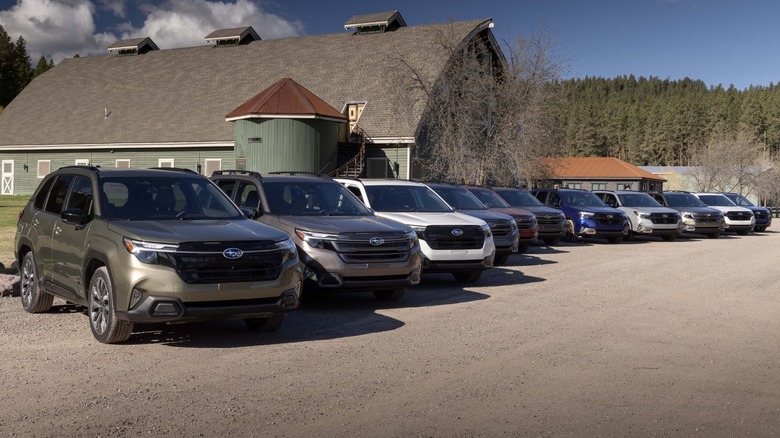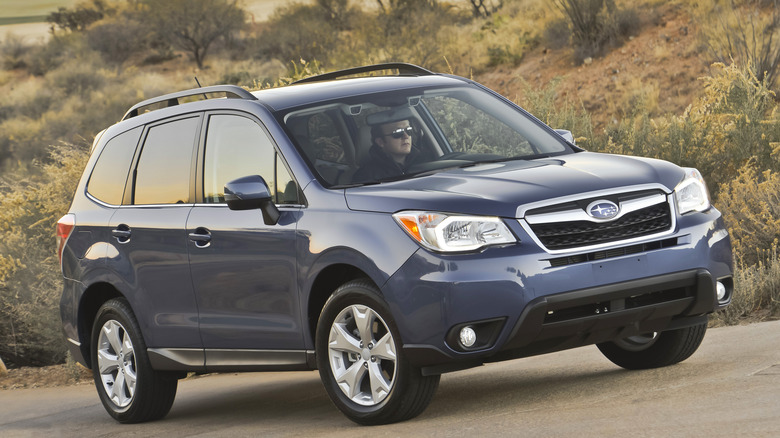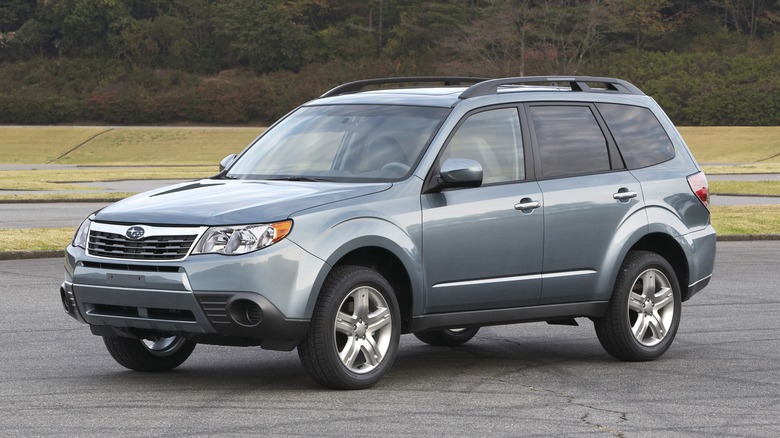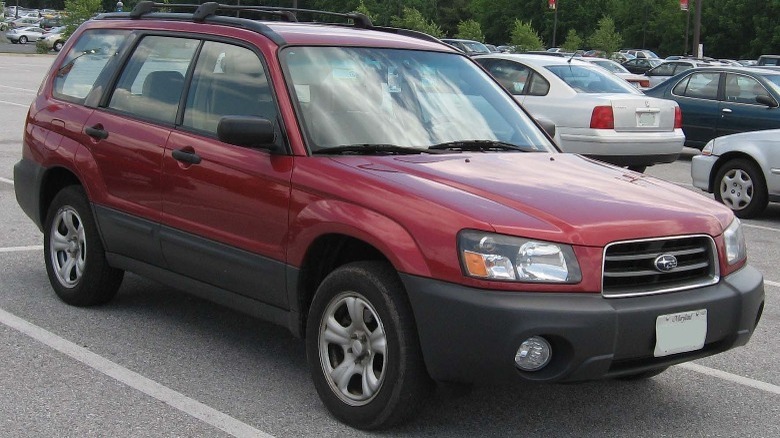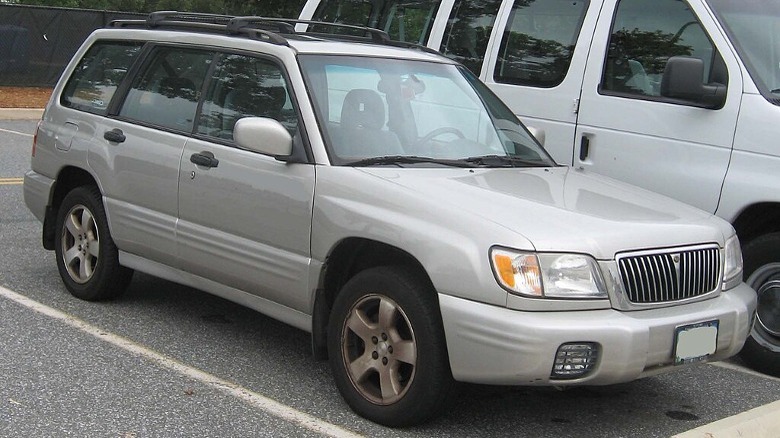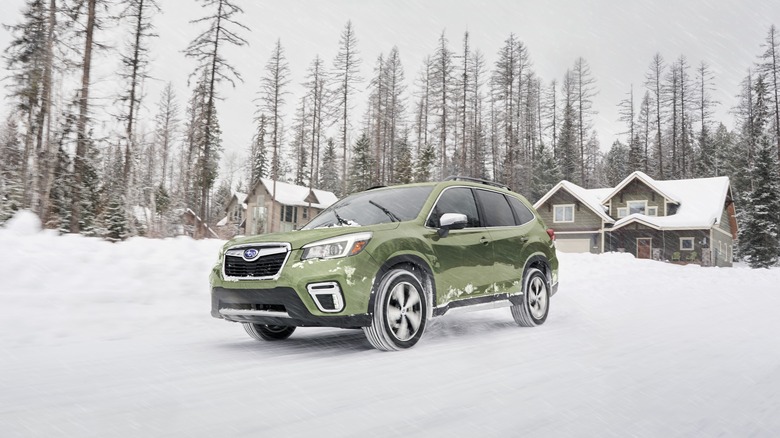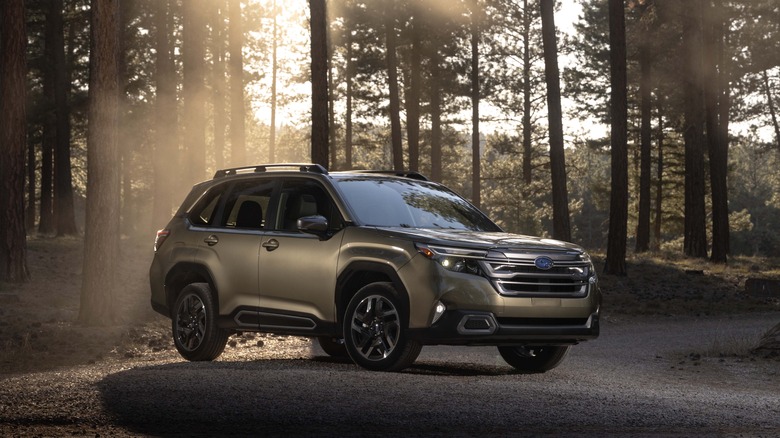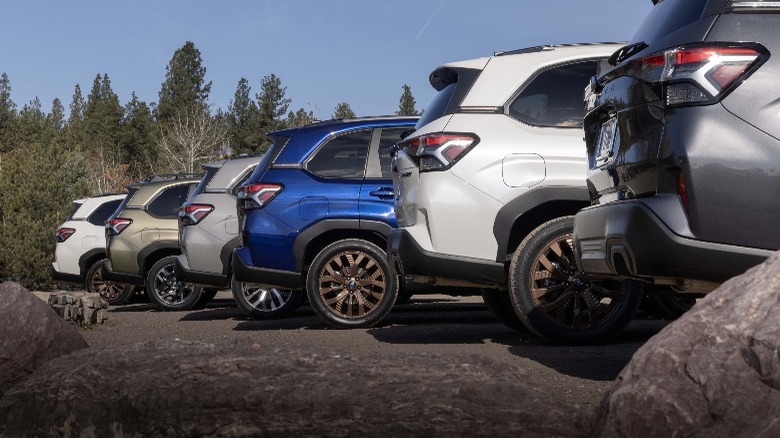Every Generation Of The Subaru Forester, Ranked Least To Most Reliable
Introduced to the American market in 1997, the Subaru Forester quickly became one of the most popular models produced by the Japanese manufacturers. It was designed to compete in the then-emerging market for crossover SUVs — and customers loved it. When it comes to performance, even though Subaru has a pretty good reputation in that regard, not all its models are the same. The Forester, while remaining one of its most versatile offerings, is not historically one of the more reliable models in Subaru's lineup.
So far, Subaru has released six generations of the Forester. While a new generation usually brings more modern, improved updates, it also sometimes comes with new problems — and, in some cases, carries over existing ones. Many of the Forester vehicles share similar issues; problems like head gasket failure and oil consumption have become generally associated with the model. Looking closely at the generations, you'll notice that some problems are more prevalent in some model years, and less in others.
However, since a generation covers a number of model years, it's important to bear in mind that even a problematic generation can have vehicles that defy the pattern, performing significantly better than the others. Regardless, an overview of their performance can give you good insight into what to look out for in each generation. With that in mind, here is every generation of the Subaru forester ranked least to most reliable.
6. Fourth Generation (2014 - 2018)
Kicking off this list as the least-reliable generation of the Subaru Forester is the 4th generation, which debuted in 2014. The number of NHTSA complaints about vehicles from the fourth generation is worrisome, especially as they involve key components like the engine and transmission. Some of its models have earned a reputation of being among the top Forester vehicles to avoid.
The problematic engine and powertrain system caused cars in this generation to lunge forward randomly or stall, posing a serious safety hazard. Despite how widespread the problem was, Subaru didn't issue a recall until the 2016 model year — and again in 2018, when certain models were recalled for stalling due to fuel pump failure. Beyond that, airbag defects are another persistent issue, with several recalls tied to this problem throughout the generation.
Another common headache with this generation is excessive oil consumption, especially in the 2014 model. Many owners report their vehicles burning up to a quart of oil every 1,000 miles — a costly and inconvenient issue for many owners. Strangely, Subaru didn't classify this as a problem. Additionally, some models suffer from suspension problems, like rear coil springs that tend to break over time, causing the vehicle to sag.
5. Third Generation (2009 - 2013)
The third generation of the Subaru Forester brought significant changes. It embraced the crossover style with a taller, larger frame, moving away from the boxier design of its predecessor to a rounder, more modern look. This generation also introduced more engine options and improved fuel efficiency, thanks in part to the addition of the continuously variable transmission (CVT).
However, in terms of reliability, third-generation Foresters don't particularly stand out. The common issues were the airbags, speed control, and engine problems, and especially noteworthy — the safety ratings. Vehicles in this generation tend to have issues with their acceleration and brakes, which make them highly susceptible to crashing, and it's quite disturbing that the airbags often fail to deploy as well. The engine issues, on the other hand, are linked to the oil consumption problems that also extended to the fourth generation.
Another red flag for this generation is the high number of recalls. Although this could suggest Subaru took steps to address complaints, the recurring need for recalls — especially for the same or similar issues — raises concerns about the long-term reliability of these vehicles.
4. Second Generation (2003 - 2008)
Debuting in 2003, the Forester's second generation made a few modifications to the first generation. It introduced a 2.5-liter turbocharged Boxer engine alongside a six-speed manual transmission. The most common issue with the fourth generation Forester was the fuel system, which continued to be a problem with subsequent generations.
Another issue notable with this generation was speed control. Owners experience unintended acceleration, where the car propels forward suddenly — which, in some cases, can lead to a crash. Also, the suspension has been a significant subject of complaints for these vehicles. Particularly, the lower front control arm, according to owners, tends to break due to corrosion. This problem causes a loss of control and can contribute to a crash. There have been recalls for this issue on all models in this generation.
Among the second-generation Foresters, the 2004 model is considered the most problematic. However, not every vehicle from this period faced significant issues: The 2008 model, for instance, is known for its reliability, with only 47 complaints filed with the NHTSA, and it has earned a reputation for solid performance.
3. First Generation (1998 - 2002)
Next on the list is the very first generation of the Forester. This model was unveiled for the first time in 1995, but did not hit the U.S. market until 1997. This generation of Foresters might not have been the most impressive design-wise, but they made up for it by building a reputation for functionality. Probably owing to their simple design, these cars have gathered the least amount of complaints overall, but that's not to say this generation doesn't have its fair share of problems.
The most prevalent issue with this generation is head gasket failure. Frankly, this issue became notorious with Subaru vehicles, including the Legacy and Outback — especially those released within this era. This issue is owed to the 2.5-liter engine that is prone to coolant fluid leakage. The effect of this is the vehicle overheating and, in worst cases, causing serious engine damage. Owners have also reported some transmission problems that affect the acceleration in these cars. That said, the 2000 and 2002 models from this generation are considered pretty reliable, with relatively few complaints compared to other years.
2. Fifth generation (2019 - 2024)
The fifth generation of the Subaru Forester introduced some interior modifications, including a wider cabin space and modern tech integrations. Its improved packaging provided a good range of features and practicality. Also, cars in this generation came with smoother performance, and all models feature a continuously variable automatic transmission.
There are some concerns about the overall driving experience in fifth-generation Foresters, but most of the issues with this model are not the most critical. The most common complaint you'll find in this generation are about the windshield. It's common for vehicles in this generation to experience windscreen cracks shortly after purchase, even with little to no force impacted on them. The 2019 model, in particular, has hundreds of complaints about this.
While Subaru didn't issue any recall for this, customers initiated a lawsuit, which is still pending as of this writing. This issue is not exclusive to the Forester, though — models like the Outback and Legacy starting from the 2017 models experience similar issues. It's worth noting that the most recent models in this Forester generation — the 2022, 2023, and 2024 — have much fewer complaints than earlier models.
1. Sixth Generation (2025 - Present)
The 2025 Subaru Forester, the latest model, marks the beginning of a new generation for this popular SUV. The vehicle retains the traditional Forester features, with an all-wheel drive train and off-road capabilities. Like previous models, it comes equipped with a 2.5-liter boxer engine producing 180 horsepower, but this version has seen improvements aimed at boosting efficiency and reducing noise levels.
This model also comes with additional upgrades on the inside and out. The exterior has a bolder design, with variations depending on the trim, and the interior, while maintaining its familiar feel, looks more refined. There's also extra passenger space, making the cabin roomier and more comfortable. As for the tech components, the Forester also introduced a rearview camera mirror, an 11.6-inch touchscreen infotainment system, and a 360-degree camera system.
While it's probably too early to judge this model in terms of reliability, sixth-generation Foresters appear to be off to a good start. The quieter and smoother driving feel, coupled with the improved steering tuning, are some of the major highlights. Whether it stands the test of time remains to be seen, but so far, it's shaping up to be a solid addition to the Forester lineup.
Our selection methodology
To determine how these eras of Forester vehicles stack against each other, we considered professional reviews and owners' feedback, as well as complaints and recalls recorded by the National Highway Traffic Safety Administration (NHTSA) for the various model years across generations. While some of these problems appear in multiple generations, some complaints have lessened over time, while many others have emerged.
Thus, we looked at the total number of issues, along with the severity of the complaints to determine which models were the most problematic. For instance, issues like the engine failure and transmission problems, which can cause the car to stall or lead to a crash, can be more severe and costly to deal with than structural defects. In addition, the average mileage when issues occur provided some insight into the durability of the various model years, and we also took this into account. Generally, Subaru hasn't issued many recalls for most Forester vehicles. So while we took this into consideration, we didn't focus too much on it.
